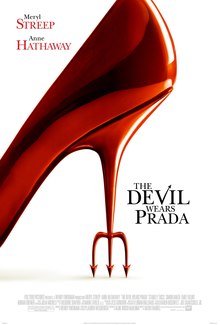

Look familiar? That red high heel was also the symbol in the critically acclaimed movie The Devil Wears Prada.In many ways, that red high heel shoe represents the evils of the fashion industry and the standards it places upon women to answer the ultimate question: What is beautiful?
Deborah Rhodes, a Stanford law professor, attempts to battle this notion of thinking by adding in another legal factor to beauty discrimination.
"Justifications for banning appearance discrimination rest on three basic claims. The first is that such discrimination offends principles of equal opportunity - individuals should be judged on merit and performance, not irrelevant physical characteristics. A second rationale is that appearance-related bias reinforces group subordination - it exacerbates disadvantages based on gender, race, ethnicity, class age and sexual orientation. A third justification is that some decisions based on appearance unduly restrict self-expression and cultural identity" (Rhode 23).
However, her line of thinking, raises many questions, especially with the entertainment industry and other jobs that depend on the media to thrive. Should publishers of romance novels be required male models who do not possess the perfect masculine body? Should fashion magazines be required to hire everyone and not simply the double zero sized women? Should everyone within every working establishment be put under oath to erase the physical appearance as a factor when hiring new employees? Thus, she feels that these measures are necessary to enforce in order to make a more permanent change within society. While I do agree that this beauty bias is certainly unjust and unfair, the difficulty of enforcing such a vague rule is too strenuous. Beauty is in the eye of the beholder, what one may find attractive may not fly with another. Therefore, the idea of beauty is subjective and cannot be equally measured among all individuals with the exception of the few very beautiful ones. I feel that putting this type of law forth would raise more questions than solve them.
Source:
Rhode, Deborah L. The Beauty Bias: The Injustice of Appearance in Life and Law. New York, NY: Oxford UP, 2010. Print.

"History has shown that stereotyping can lead to scapegoating, which can lead to discrimination, which can lead to segregation, which can led to physical abuse, which can lead to state-sponsored genocide" (Lester 10).
This is probably one of the more powerful quotes I have read in awhile. Mostly, because while I was reading this quote, I was able to immediately conjure up several examples within my mind. The most famous example coming into mind was almost exactly identical to the pattern stated above. It led to discrimination of Jews with the increasingly gradual rise of Hitler, which then eventually led to their segregation into internment camps. Then, within the camps, Jews faced physical abuse, death, torture to becoming the national genocide, which we now recognize as the Holocaust. The discrimination Jews faced were further exacerbated with the media, more specifically the newspaper, television, and books in order to steer the general public toward Hitler's beliefs and accept the cruel fate of the Jews.

Source:
Lester, Paul Martin. Images That Injure: Pictorial Stereotypes in the Media. Westport, CT: Praeger, 1996. Print.
No comments:
Post a Comment